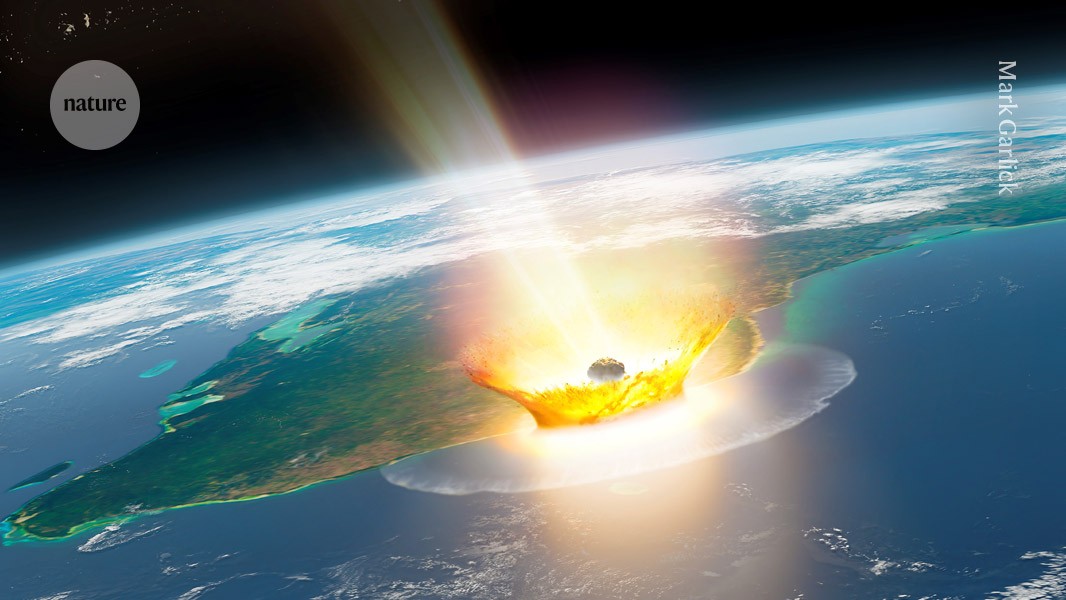Dinosaur-killing Chicxulub asteroid formed in Solar System’s outer reaches

Rock samples hold clues to origin of impactor that sparked a mass extinction 66 million years ago

The impact from the Chicxulub asteroid (illustration) caused a mass extinction 66 million years ago.Credit: Illustration by Mark Garlick
The object that smashed into Earth and kick-started the extinction that wiped out almost all dinosaurs 66 million years ago was an asteroid that originally formed beyond the orbit of Jupiter, according to geochemical evidence from the impact site in Chicxulub, Mexico.
The findings, published on 15 August in Science1, suggest that the mass extinction was the result of a train of events that began during the birth of the Solar System. Scientists had long suspected that the Chicxulub impactor, as it is known, was an asteroid from the outer Solar System, and these observations bolster the case.
The Cretaceous/Palaeogene (K/Pg) extinction was the fifth in a series of mass extinctions that have occurred during the past 540 million years or so: the period in which animals have spread around Earth. The event wiped out more than 60% of species, including all non-avian dinosaurs.
Since 1980, evidence has accumulated that the extinction was caused by a city-sized object hitting Earth. Such an impact would have thrown huge volumes of sulfur, dust and soot into the air, partially blocking out the Sun and causing temperatures to plummet. A layer of iridium metal, which is rare on Earth but more common in asteroids, was deposited all over the planet around the time the extinction began. And in the 1990s, scientists described2 the impact site, a huge buried crater near Chicxulub on Mexico’s Yucatán Peninsula.
“We wanted to identify the origin of this impactor,” says Mario Fischer-Gödde, an isotope geochemist at the University of Cologne in Germany. To find out what the object was and where it came from, he and his colleagues obtained samples of K/Pg rocks from three sites, and compared them with rocks from eight other impact sites from the past 3.5 billion years.
Ruthenium signature
The team focused on isotopes of ruthenium metal. Ruthenium is extremely rare in Earth rocks, says Fischer-Gödde, so samples of it from an impact site offer “the pure signature” of the impactor. There are seven stable isotopes of ruthenium, and celestial bodies have characteristic blends of them.
In particular, looking at ruthenium isotopes can help researchers to distinguish between asteroids that formed in the outer Solar System — beyond the orbit of Jupiter — and those with an origin in the inner Solar System. When the Solar System was forming from a molecular cloud around 4.5 billion years ago, temperatures in the inner region were too high for volatile chemicals such as water to condense. As a result, asteroids produced there had low levels of volatiles, and became rich in silicate minerals. Asteroids that formed further out became ‘carbonaceous’, containing lots of carbon and volatile chemicals. Ruthenium isotopes were unevenly distributed in the cloud, and this heterogeneity is preserved in asteroids.
Fischer-Gödde’s team found that the ruthenium isotopes in the Chicxulub impactor were a good match for a carbonaceous asteroid from the outer Solar System, and did not match siliceous asteroids from the inner Solar System.
Previous studies have also suggested that the impactor was a carbonaceous asteroid, says Sean Gulick, a geophysicist at the University of Texas at Austin. But the latest work “is a really elegant way to get at some of these same answers and get several of the same answers using one methodology”, he adds.
Not a comet
The ruthenium isotopes also provide evidence against another hypothesis: that the Chicxulub impactor was a comet rather than an asteroid. “The idea it was a comet goes back far into the literature,” says William Bottke, a planetary scientist at the Southwest Research Institute in Boulder, Colorado. The hypothesis was revived in a controversial 2021 study3, which argued that the impactor was part of a long-period comet that had broken up under the Sun’s gravitational pull.
But Fischer-Gödde says the ruthenium-isotope data do not match a comet. Gulick agrees. He adds that geochemical evidence from the Chicxulub impact site has never been consistent with a comet, and the latest study “does a really good job of kind of nailing that home”.
Bottke adds that the comet hypothesis also “runs into difficulty” when you consider the dynamics of the Solar System. “Sizeable carbonaceous asteroids are much more probable to hit the Earth than comets,” he says. In a 2021 study, he and his colleagues argued that the impactor probably came from the main asteroid belt, between Mars and Jupiter.
Most of the other impactors that Fischer-Gödde’s team studied seem to have formed in the inner Solar System, according to their ruthenium isotopes. The only exceptions were the oldest ones, from between 3.2 billion and 3.5 billion years ago, which look more like the Chicxulub impactor. It could be that “something interesting was happening in the asteroid belt at that time, such as a large asteroid break-up in a good place to deliver objects to Earth”, says Bottke.
doi: https://doi.org/10.1038/d41586-024-02647-4
This story originally appeared on: Nature - Author:Michael Marshall


















